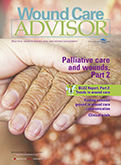By Nancy Morgan, RN, BSN, MBA, WOC, WCC, DWC, OMS
Each issue, Apple Bites brings you a tool you can apply in your daily practice.
Measurement of wounds is an important component of wound assessment and provides baseline measurements, enables monitoring of healing rates, and helps distinguish among wounds that are static, deteriorating, or improving. All alterations in skin integrity, including those caused by ulcers, venous ulcers, arterial ulcers, neuropathic ulcers, incision lines, grafts, donor sites, abscesses, and rashes should be measured when they’re discovered and at intervals thereafter, based on institutional policy. (more…)
Read More

